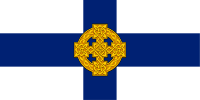Church in Wales
The Church in Wales (Welsh: Yr Eglwys yng Nghymru) is the Anglican church in Wales, composed of six dioceses.[3] In 2000, membership figures taken as a percentage of the population was 1.6%.[4] Between 1996 and 2016 the number of signed-up Church in Wales members dropped from 91,247 to 45,759 [5] or 1.5% out of a total population of 3,113,150 [6] The number of Church in Wales members on the "Electoral Roll" dropped further to 42,441 by 2018 [7][8] or 1.4% out of the total Welsh population of 3,187,203[9][10] The Anglican church claims to be the largest denomination in Wales.[11]
| Church in Wales Yr Eglwys yng Nghymru | |
|---|---|
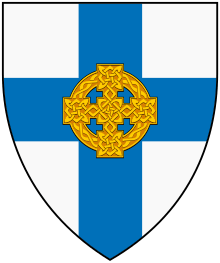 Coat of arms of the Church in Wales | |
| Primate | Archbishop of Wales John Davies, Bishop of Swansea and Brecon |
| Language | Welsh and English |
| Headquarters | Cardiff |
| Territory | Wales with 1,500 congregations[1] |
| Independence | 1920 (Disestablishment) |
| Members | 45,759 (2016) [2] |
| Official website | churchinwales.org.uk |
| Part of a series on |
| Anglicanism |
|---|
 |
|
|
|
Background and history |
|
|
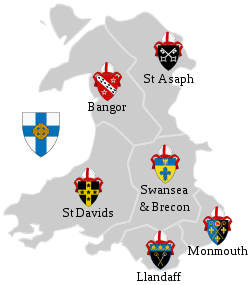
The Archbishop of Wales does not have a fixed archiepiscopal see, but serves concurrently as one of the six diocesan bishops. The position is currently held by John Davies, Bishop of Swansea and Brecon.
Unlike the Church of England, the Church in Wales is not an established church. Disestablishment took place in 1920 under the Welsh Church Act 1914.[12]
As a province of the Anglican Communion, the Church in Wales recognises the Archbishop of Canterbury as a focus of unity but without any formal authority.[13] A cleric of the Church in Wales can be appointed to posts in the Church of England, including the See of Canterbury; the former Archbishop of Canterbury, Rowan Williams, was from Wales and served as Archbishop of Wales before his appointment to Canterbury.
Official name
The Church in Wales (Welsh: Yr Eglwys yng Nghymru) adopted its name by accident. The Welsh Church Act 1914 referred throughout to "the Church in Wales", the phrase being used to indicate the part of the Church of England within Wales. In 1920, a convention of the Welsh church considered what name to select and tended to favour "the Church of Wales". However, there were concerns that adopting a name different from that mentioned in the Act might cause legal problems. Given the situation, it seemed sensible to adopt the title "the Church in Wales".
History
Christianity in Wales can be traced back to the Romano-British period and an organised episcopal church has had continuous existence in Wales since that time. Wales became a refuge for other Britons following the pagan Anglo-Saxon invasion of what became England. The Welsh refused to co-operate with Augustine of Canterbury's mission to the Anglo-Saxons. However, a combination of other Celtic dioceses reconciling with the See of Rome and the English conquest of Wales meant that from the Middle Ages, the Welsh dioceses were part of the Province of Canterbury and also in communion with the See of Rome until the English Reformation. Afterward they were part of the Church of England until disestablishment in 1920. From the time of Henry VIII, Wales had been absorbed into England as a legal entity and the established church in Wales was the Church of England.
Disestablishment
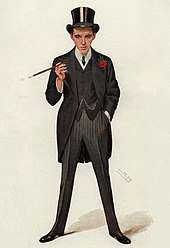
During the 19th century, Nonconformist churches grew rapidly in Wales, and eventually the majority of Welsh Christians were Nonconformists, although the Church of England remained the largest single denomination. By the mid-19th century the failure to appoint a Welsh-speaking bishop to any Welsh diocese for 150 years caused real resentment; disestablishment was seen as a way to assert national and linguistic identity.
Under the influence of Nonconformist politicians such as David Lloyd George, the Welsh Church Act 1914 was passed by the Liberal Government to separate Anglicanism in Wales from the Church of England. The bill was fiercely resisted by members of the Conservative Party and blocked in the House of Lords, but it was eventually passed under the provisions of the Parliament Act 1911.
The opposition to disestablishment was led by the Conservative politician F. E. Smith, who characterised the disestablishment bill as "a Bill which has shocked the conscience of every Christian community in Europe." In response to this description, the writer G. K. Chesterton penned the satirical poem "Antichrist, or the Reunion of Christendom: An Ode" containing the memorable retort "Chuck It, Smith".[14]
The Act both disestablished and disendowed the "Church in Wales", the term used to define the part of the Church of England which was to be separated. Disestablishment meant the end of the church's special legal status, and Welsh bishops were no longer entitled to sit in the House of Lords as Lords Spiritual. As the Church in Wales became independent of the state, tithes were no longer available to the church, leaving it without a major source of income.
Disendowment, which was even more controversial than disestablishment, meant that the endowments of the Church in Wales were partially confiscated, and redistributed to the University of Wales and local authorities. Endowments before 1662 were to be confiscated; those of later date were to remain. This was justified by the theory that the pre-1662 endowments had been granted to the national church of the whole population, and hence belonged to the people as a whole rather than to the Church in Wales; understandably, this reasoning was hotly contested. The date 1662 was that of the Act of Uniformity following the Restoration; it was after this point that Nonconformist congregations began to develop and the Church of England ceased to be a comprehensive national church. Although secularisation of the cathedrals had been suggested, the Church in Wales retained all the ancient church buildings and the privilege of conducting legal marriages without reference to the civil registrar.
Due to the outbreak of World War I in 1914, the Welsh Church Act 1914 was passed together with the Suspensory Act 1914, meaning that the Welsh Church Act would not be implemented for the duration of the war. Disestablishment finally came into effect in 1920. The Church in Wales adopted a written constitution and elected a Governing Body which initially met once a year, but now meets twice annually. The Governing Body has ultimate authority "to approve liturgies, review organizational structures, and secure firm fiscal resources for the mission and ministry of the church". The Church in Wales was one of the first members of the Anglican Communion to adopt synodical government.[15]
Since 1920
Parishes overlapping the border were allowed to vote either to accede to the Church in Wales or to continue in the Church of England; so the line of disestablishment is not the same as the border between the two countries. A few districts in the former counties of Monmouthshire, Radnorshire and Flintshire remain attached to parishes in the Dioceses of Hereford and Chester and consequently they are part of the Church of England. A complete English rural deanery with the generalised name March containing Oswestry and areas to the north-west of Shrewsbury, was transferred from its historic setting in the Diocese of St Asaph to be consistent with the civil border there. The churches of St Mary, Caernarfon, and Llangadwaladr, Anglesey, were transferred from the Diocese of Chester to that of Bangor.
Today, the Church in Wales is fully independent of both the state and the Church of England. It is an independent member of the Anglican Communion, as are the Church of Ireland and the Scottish Episcopal Church.
In the first years of the 21st century, the Church in Wales has begun to engage in numerous debates. These particularly concern the appointment of women to the episcopate and the provincial recognition of the equal statuses of the Welsh and English languages in all aspects of church life.
Membership
Following disestablishment in 1920, the Church in Wales initially fared better than the Nonconformist churches, which suffered a decline during the late 20th century. The Anglican Church does not have "a single definition of 'membership' in the Church in Wales."[16] In 2006 the average weekly attendance was recorded at 6,780 aged under 18 and 39,490 aged over 18. The highest attendance was at Easter, with 68,120 at worship (68,837 in 2007).[17] In 2014, the attendance in the Church in Wales was 52,021 at Easter: a decline of about 16,000 members since 2007, but an increase from 2013. Also, in 2014, nineteen churches were closed or made redundant. Overall, in 2014, the Church in Wales reported 152,000 attenders in its parishes and congregations, compared to 105,000 in 2013.[18] In 2018, the number of communicants during Easter was 46,163 and the number of persons on the Electoral Roll was 42,441.[7]
From 2015 statistics, when all "other major acts of worship" are included, the church reported having 206,000 total attenders. "Such additional services, which include civic services, family services, Remembrance, Carol and Christingle services, registered a total attendance of some 206,000 in 2015, compared with 152,000 in 2014."[19][16] In 2017, "parishes recorded 210,000 people attending other types of traditional worship, which might include civic services, family services, Remembrance, Carol and Christingle services."[20]
Structure
The polity of the Church in Wales is episcopal church governance, which is the same as other Anglican churches.
Prior to 1920, there were four dioceses in Wales, all part of the Province of Canterbury and each led by its own bishop:
- The Diocese of Bangor
- The Diocese of St Asaph
- The Diocese of St Davids
- The Diocese of Llandaff
Two additional dioceses were erected soon after the creation of the Church in Wales:
- The Diocese of Monmouth in 1921
- The Diocese of Swansea and Brecon in 1923
Monmouth was created from one of the archdeaconries of Llandaff diocese. Swansea and Brecon was created from the eastern part of the St Davids diocese, largely corresponding to the city and county of Swansea and the traditional counties of Breconshire and Radnorshire.
Each diocese is divided into two or three archdeaconries, with 15 of these in total. Each has an archdeacon, who is responsible to the bishop for its administration. The archdeaconries are further divided into deaneries.
Each diocese has its own cathedral, the "mother church" of the diocese and the seat of the bishop. In the cathedral are held important events such as the enthronement of a new bishop. Each cathedral has a Dean, appointed to manage the cathedral, with the assistance of the Chapter. Together with the Archdeacons, the Dean of the Cathedral is one of the most prominent clerics of the diocese, after the Bishop. The Chapter is composed of the Dean and a number of Canons selected from among the clerics of the diocese.
Diocesan and Episcopal coats of arms
The following Episcopal coats of arms are those each bishop is privileged to carry whilst in office. The official Diocesan coat of arms is identical to the Episcopal version, however does not carry the mitre. With the introduction of the new logos for many of the diocese, their strict use has fallen away during recent years (generally since 2006 onwards), and as such, the coats of arms are often used synonymously.
 Bangor
Bangor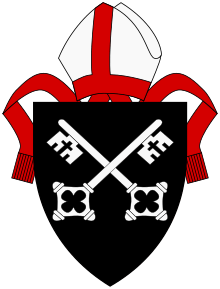 St Asaph
St Asaph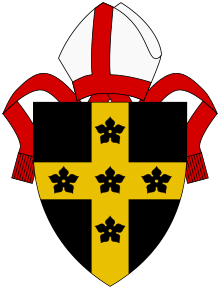 St Davids
St Davids Swansea and Brecon
Swansea and Brecon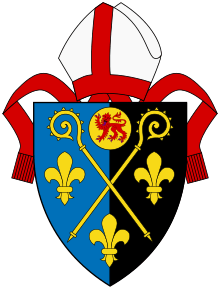 Monmouth
Monmouth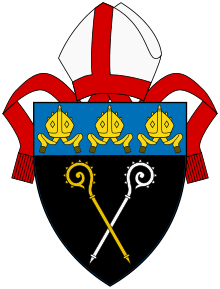 Llandaff
Llandaff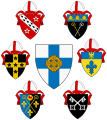 Combined
Combined
Archbishop
Until 1920 the Welsh church was part of the Church of England and under the metropolitical jurisdiction of the Archbishop of Canterbury. Since independence in 1920, the Church in Wales has been led by the Archbishop of Wales, who is both the metropolitan bishop and primate. The Archbishop of Wales is elected from the currently seated diocesan bishops and continues as a diocesan after election. It is a commonly held misconception that there must be six diocesan bishops in order to hold the electoral college for the Archbishop of Wales. However, the Constitution of the Church in Wales specifies no quantity of Bishops, simply referring to the electoral college as being made up of "the Bishops and the first three clerical and the first three lay Episcopal Electors on the list of each Diocese in the Church in Wales."[21] In an archiepiscopal vacancy, the senior Bishop by appointment is acting archbishop.[22]
A former Archbishop of Wales, Rowan Williams, became the first Welsh-born Archbishop of Canterbury. He was consecrated and enthroned as Bishop of Monmouth in 1992 and as Archbishop of Wales in 1999. He was appointed by the Queen (his appointment having been proposed by the Crown Appointments Commission) as Archbishop of Canterbury in July 2002.
Diocesan bishops
Unlike bishops in the Church of England, each bishop of the Church in Wales is elected by an "electoral college" which consists of representatives of the diocese in which a vacancy occurs, representatives of the other dioceses in Wales and all bishops of the church. In 2013 the Church in Wales officially agreed to the ordination of women as bishops, five years after a previous proposal for their ordination failed in 2008.[23]
In descending order of seniority, as of January 2020, when Cherry Vann was consecrated bishop, the bench of Welsh bishops consists of:
- John Davies, Bishop of Swansea and Brecon, and Archbishop of Wales
- Andrew John, Bishop of Bangor
- Gregory Cameron, Bishop of St Asaph
- Joanna Penberthy, Bishop of St Davids
- June Osborne, Bishop of Llandaff
- Cherry Vann, Bishop of Monmouth
In cases where a see is vacant due to the death or translation of a bishop, episcopal acts such as ordinations and confirmations are carried out by the archbishop or by another bishop appointed for that purpose by the archbishop.
Assistant bishops
Assistant bishops may be appointed within the Church in Wales. In practice, diocesan assistant bishops have only been appointed within the diocese of the archbishop, in order to assist him with diocesan episcopal functions. There are no assistant bishops at present in the Church in Wales. The previous archbishop had an Assistant Bishop of Llandaff. From April 2009 to April 2017 the post was held by David Wilbourne.[24] See also: Assistant Bishop of St Asaph.
A provincial assistant bishop was appointed in 1996 to provide episcopal ministry to congregations which could not accept the ministry of bishops who ordained women. David Thomas held the position for twelve years, retiring in 2008. At that time the Bench of Bishops decided that it would not continue to appoint a specific bishop to minister to those who cannot in conscience accept the ordination of women as priests. This point was reiterated by Barry Morgan at the Governing Body of the Church in Wales in September 2013 during the debate on whether or not the Church in Wales would ordain women to the episcopate.
Historically, there have been suffragan bishops both before and since disestablishment, including two Bishops of Swansea and one Bishop of Maenan. From 1946 until his death in 1953, Richard William Jones (Archdeacon of Llandaff and Rector of Peterston-super-Ely) was "Assistant Bishop of Wales".[25]
Representative Body
The Representative Body of the Church in Wales is responsible for the care of the church's property and for funding many of the activities of the church, including support for priests' stipends and pensions.
Governing Body
The Governing Body is responsible for decisions that affect the Church's Faith, Order and Worship. It also has powers to make regulations for the general management and good government of the Church, and its property and affairs. The Governing Body is the supreme legislature of the Church in Wales, broadly speaking the Parliament of the Church in Wales. It usually meets twice a year to receive reports and make decisions on matters brought before it.[26]
Worship and liturgy
The Church in Wales as a whole tends to be predominantly High Church, meaning that many of the traditions are inherited from the Oxford Movement in more rural dioceses such as St Davids and Bangor and especially in the industrial parishes of Llandaff and Monmouth. Although the province tends more toward liberal and Anglo-Catholic positions in theology and liturgy, it also has a tradition of evangelicalism, especially in the southern parts of Wales, and the university town of Aberystwyth. In the 1960s there was a revival of evangelicalism within the Church in Wales and the Evangelical Fellowship of the Church in Wales exists to support such members of the church.
Book of Common Prayer
An Act of Parliament passed in the year 1563, entitled "An Act for the Translating of the Bible and the Divine Service into the Welsh Tongue," ordered that the Old and New Testament, together with the Book of Common Prayer, were to be translated into Welsh. A translation by Richard Davies, bishop of St Davids and the scholar William Salesbury was published in 1567[27] by Humphrey Toy as Y Llyfr Gweddi Gyffredin. A new revision — based on the 1662 English revision and probably by George Griffith, Bishop of St Asaph - was published in 1664.(Muss-Arnolt 1914, Ch VII) The 1662 book and its Welsh equivalent continued to be used, even after the Church in Wales was disestablished in 1920.
The Church in Wales began revising the Book of Common Prayer in the 1950s. The first material authorised for experimental use was a lectionary in 1956, followed by a baptism and confirmation service in 1958, an order for Holy Matrimony in 1960, and an order for the Burial of the Dead in 1962. These did not however enjoy widespread use. In 1966 an experimental order for the Holy Eucharist was authorised. This was the first to enjoy widespread use. Revision continued throughout the 60s and 70s, with an experimental version of morning and evening prayer in 1969. In 1971 a definitive version of baptism and confirmation was authorised, replacing the equivalent in the 1662 Book of Common Prayer. This was followed in 1974 with a definitive order for the Burial of the Dead, and in 1975 with a definitive order for Holy Matrimony. It was hoped that a new Book of Common Prayer for the church in Wales would be produced in 1981. However, in 1979 a definitive version of the Holy Eucharist failed to gain a two-thirds majority in the House of Clergy and the House of Laity at the Governing Body. A light revision of the 1966 experimental Eucharist was approved by the Governing Body, and the Book of Common Prayer for use in the Church in Wales was authorised in 1984. This Prayer Book is unique in that it is in traditional English. The Church in Wales first considered a modern language Eucharist in the early 70s but this received a lukewarm reception. A modern language Eucharist (The Holy Eucharist in modern language) was authorised alongside the new prayer book in 1984, but this did not enjoy widespread use. In 1990 new initiation services were authorised, followed in 1992 by an alternative order for morning and evening prayer[28] in 1994 by an alternative order for the Holy Eucharist, in 1995 by the alternative calendar lectionary and collects, and in 1998 an order for compline was produced. These enjoyed widespread use. In 2003 a new calendar and collects was made part of the Book of Common Prayer for use in the Church in Wales. This was followed in 2004 by an order for the Holy Eucharist, services for Christian initiation in 2006 and in 2009 by daily prayer. Experimental services continued, with an ordinal produced in 2004, Ministry to the Sick and Housebound in 2007, healing services in 2008, funeral services in 2009, and in 2010 marriage services which became part of the Book of Common Prayer in 2013. The ordinal was made part of the prayer book the following year. In 2017 prayers for a child were released, together with a Revised Order for Confirmation, the latter authorised for five years experimental use following the bench of Bishops' decision to admit unconfirmed children and adults to communion.[29] In 2018 Times and Seasons was released. All of these were published on line.[30][31] The following year Funeral Services became part of the Book of Common Prayer, and additional prayers for different events in life were launched (Blessing of a home, prayers for victims of crime etc.).
Other publications
Discontinued publications which frequently provided articles of sub-academic quality were Province, Yr Haul â'r Gangell, and Y Llan. Bi-annual news from the Governing Body meeting is released in Highlights. News is predominantly circulated on the Church in Wales' Provincial and Diocesan Websites, and in various Diocesan Magazines.
Doctrine and practice
Central to the teaching of the Church in Wales is the life, death and resurrection of Jesus Christ. The basic teachings of the church, or catechism, include:
- Jesus Christ is fully human and fully God. He died and was resurrected from the dead.
- Jesus continues to provide the way to eternal life for those who believe.
- The Old and New Testaments were written by people "under the inspiration of the Holy Spirit". The Apocrypha are additional books that are used in Christian worship, but not for the formation of doctrine.
- The two great and necessary sacraments are Holy Baptism and Holy Eucharist
- Other sacramental rites are confirmation, holy orders, matrimony, reconciliation of a penitent, and anointing of the sick.
- Belief in heaven, hell, and Jesus' return in glory.
The balance of Scripture, tradition and reason as authority for faith and practice is traced to the work of Richard Hooker, a sixteenth-century apologist. In Hooker's model, Scripture is the primary means of arriving at doctrine, and things stated plainly in Scripture are accepted as true. Issues that are ambiguous are determined by tradition, which is checked by reason.[32]
Ordination of women
A proposal to ordain women as priests was introduced and debated in 1995 after it had failed to secure a two-thirds majority in 1994.[33] The ordination of women to the priesthood was approved by the two-thirds majority in 1996.[34] The Church in Wales has ordained women as priests since 1997.[35] Prior to 1997, women were permitted to serve as deacons.[36] The first deaconess was consecrated in 1884.[37] In 2013, the church voted to allow women to serve as bishops. In 2016, Canon Joanna Penberthy was elected the first woman bishop in the church.[38] Penberthy was enthroned as Bishop of St Davids on 11 February 2017. As of 2020, following the enthronement of The Right Reverend Cherry Vann as Bishop of Monmouth,[39] there are three women bishops sitting on the Welsh Bench of Bishops.
Same-sex unions and LGBT clergy
Beginning in the 1980s, the Church in Wales embarked on an increasingly open stand on various issues including economic justice, the ordination of women and inclusion of homosexual people. In some areas, such as human sexuality, the church establishment has faced resistance from congregations. In 2005, the church allowed gay priests to enter into civil partnerships.[40] "In the wake of civil partnerships, the Welsh Bishops sought legal advice, and told gay partnered clergy that they were welcome, as well as gay ordination candidates."[41] Speaking on such partnerships, it was communicated that “The Church in Wales has no formal view on whether people in civil partnerships who are in a sexual relationship can serve as clergy. If the issue arises, it is up to the relevant Bishop to decide."[40] Therefore, the Welsh church does not require abstinence for clergy in civil unions.[42] Regarding transgender issues, an officer announced that the church believes transgender people "should be acknowledged and celebrated in their new gender."[43] Currently, "the Church has published prayers that may be said with a couple following the celebration of a [same-sex] civil partnership or civil marriage."[44]
Currently, "the Church in Wales is much more liberal on this issue [than the Church of England]" and is discussing the possibility of blessing or performing same-sex marriages.[45] In 2018, the Welsh Bishops released a statement saying it was "unjust" to not offer formal provision for same-sex marriages and civil partnerships.[46] Following the bishops' announcement, the General Synod voted in favour of requesting formal provision for same-sex couples.[47] The Welsh Church has decided to move forward with possibly offering same-sex marriage and blessing rites for same-sex unions.[48] The Diocese of St. Asaph provides a chaplaincy and services for LGBT people.[49] The Very Revd Jeffrey John, who is openly gay and in a civil union, was nearly elected bishop of Llandaff when he "won more than half of a Church in Wales electoral college, but fell short of the two-thirds majority required."[50] As of 2020, the Church in Wales has approved the consecration of a bishop, Bishop Cherry Vann, who is openly lesbian and in a civil partnership.[51][52]
"The Anglican Church In Wales took the first steps towards allowing clergy to celebrate same sex marriage in its churches when more than half its Governing Body voted in favour of the move."[53] In the 2016 results, 52% of the Governing Body voted in favour of allowing same-sex marriages in church.[54] "Members of the Church in Wales Governing Body voted 61 in favour of gay marriages in church, nine in favour of blessing gay partnerships and 50 for making no change."[55] As a result of the majority support for same-sex couples, but not a two-thirds majority needed to create a same-sex marriage ceremony, the church's Bench of Bishops affirmed members in same-sex relationships and "published a series of prayers which may be said with a couple following the celebration of a civil partnership or civil marriage."[56][57][58] The service, in Form One, gives God thanks "for [the two people] who have found such love and companionship in each other, that it has led them to dedicate their lives in support of one another."[59]
Ecumenical relations
Like many other Anglican provinces, the Church in Wales entered into full communion with the Old Catholics. The Church in Wales is also a member of the Porvoo Communion. Because of the Anglo-Catholic dominance, relations with the Free Churches (formerly known during establishment times as Nonconformists), ecumenical progress has been slower in Wales than in England. The Church in Wales is a member of the Covenanted Churches in Wales.[60] A covenant (with church unity as an ultimate goal) was signed by the Church in Wales, the Methodist Church, the Presbyterian Church of Wales, the United Reformed Church, and some Baptist churches in 1982 under the title of Enfys ("rainbow").
See also
- Cytûn – Churches Together in Wales
- List of archdeacons in the Church in Wales
- List of Church in Wales churches
References
- "Representative Body". churchinwales.org.uk. Church in Wales. Retrieved 11 February 2016.
- Y Catechism; Amelinelliad o'r Ffydd – The Catechism: An Outline of the Faith. Section III, clause 25, p. 7 (Caerdydd/Cardiff. Gwasg yr Eglwys yng Nghymru/Church in Wales Publications 1993)
- Figure 3 Anglican Church Membership as Percentage of Population
- Church in Wales
- Statistics Wales National level population estimates by year
- Church in Wales Membership & Finance 2018
- Church in Wales annual report on membership and finance for 2018 page 4
- UK population Wales
- Membership Finance 2019
- Office, Anglican Communion. "Member Church – Wales". www.anglicancommunion.org. Retrieved 30 January 2018.
- Eighteen cross-border parishes remained in the Church of England and were exempt from disestablishment, The First Report of the Commissioners for Church Temporalities in Wales (1914–16) Cd 8166, p 5; Second Report of the Commissioners for Church Temporalities in Wales (1917–18) Cd 8472 viii 93, p 4
- Except for residual roles — in ecclesiastical court to try the archbishop, as metropolitan; and the appointment of notaries, and the granting of Special Marriage Licences, s.6, Welsh Church (Temporalities) Act 1919. Both these functions formed part of the jurisdiction of the Papal Legate which were transferred to the Archbishop of Canterbury at the Reformation.
- "Antichrist, or the Reunion of Christendom: An Ode".
- Markham, Ian S.; Hawkins, J. Barney; Terry, Justyn; Steffensen, Leslie Nuñez (2013). The Wiley-Blackwell Companion to the Anglican Communion. John Wiley & Sons. pp. 521–523. ISBN 978-1-118-32086-0.
- "The Church in Wales Membership and Finances" (PDF). churchinwales.org.uk. 2017. Retrieved 17 September 2018.
- churchinwales.org.uk Archived 14 November 2007 at the Wayback Machine
- "Church in Wales Membership and Finances" (PDF). www.churchinwales.org.uk. Church in Wales. Retrieved 1 November 2015.
- "Church in Wales: Membership and Finances 2015" (PDF). churchinwales.org.uk. Church in Wales. 2016. Retrieved 27 September 2016.
- "The Church in Wales Membership and Finances 2017" (PDF). churchinwales.org.uk. 2017.
- Constitution of the Church in Wales, Chapter V, Paragraph V. (Accessed 19 May 2017)
- Constitution of the Church in Wales, Chapter V Part II, Section 9 (Accessed 5 January 2017)
- "Female Bishops approved by Church in Wales", The Guardian, 12 September 2013.
- Bishops' biodata Archived 7 June 2011 at the Wayback Machine, Church in Wales website
- "Jones, Richard William". Who's Who. ukwhoswho.com. A & C Black, an imprint of Bloomsbury Publishing plc. (subscription or UK public library membership required)
- Wales, The Church in. "Governing Body". The Church in Wales.
- Procter, F; Frere, W H (1902). A New History of the Book of Common Prayer. St. Martin's Press. p. 125.
- Wales, The Church in. "Morning & Evening prayer, an alternative order". The Church in Wales.
- "Confirmation: Revised Order for (2017)".
- Wales, The Church in. "Child – Prayers for a". The Church in Wales.
- Wales, The Church in. "Times and Seasons – vol 1 – Advent to Candlemas". The Church in Wales.
- Anglican Listening Archived 5 July 2008 at the Wayback Machine goes into detail on how scripture, tradition, and reason work to "uphold and critique each other in a dynamic way".
- "Welsh plan for women priests". The Independent. 16 April 1995. Retrieved 30 March 2018.
- Herd, George (2017). "Church marks 20 years of women priests". BBC News. Retrieved 30 March 2018.
- "Church in Wales Celebrates Ten Years of Women Priests". www.christiantoday.com. Retrieved 2 November 2016.
- "Welsh women deacons made priests". The Irish Times. Retrieved 2 November 2016.
- "'Crossing Thresholds' – history of women's ministry in Wales – The Church in Wales". The Church in Wales. Retrieved 30 March 2018.
- "Canon Joanna Penberthy elected Wales' first woman bishop". BBC News. 2 November 2016. Retrieved 2 November 2016.
- "New Bishop of Monmouth Cherry Vann enthroned in Newport". South Wales Argus. 1 February 2020. Retrieved 3 February 2020.
- "Church in Wales looks at pension rights for clerics' partners". 15 September 2011. Retrieved 6 September 2016.
- "Gay marriage in the Church in Wales; and the issue of bisexuality". www.churchtimes.co.uk. Retrieved 28 April 2018.
- "Leading Gay Cleric Jeffrey John Narrowly Rejected As Bishop In Wales". www.christiantoday.com. Retrieved 9 April 2017.
- Williamson, David (23 April 2009). "Funding sex change therapy in Wales is a life-saver, says transgender journalist". Retrieved 16 September 2016.
- James, David (6 April 2016). "The Church in Wales has apologised to gay and lesbian people". walesonline. Retrieved 2 June 2017.
- "Gay marriage: MP Bryant says church stance 'wrong'". 15 January 2016. Retrieved 29 May 2016.
- Williamson, David (12 September 2018). "Gay marriage in Welsh churches? Welsh bishops say it is 'unjust' not to". walesonline. Retrieved 13 September 2018.
- "Provision explored for same sex couples". BBC News. 12 September 2018. Retrieved 13 September 2018.
- Premier (13 September 2018). "Church in Wales to consider allowing gay marriage – Premier". Premier. Retrieved 13 September 2018.
- "LGBTQIA chaplaincy – The Diocese of St. Asaph". The Diocese of St. Asaph. Retrieved 26 May 2017.
- Shipton, Martin (9 March 2017). "Gay cleric 'rejected as Bishop of Llandaff' despite winning half the votes". walesonline. Retrieved 30 March 2018.
- "New Bishop's consecration". Church in Wales. Retrieved 21 January 2020.
- "Gay bishop will not push for same-sex marriage". BBC News. 28 January 2020. Retrieved 29 January 2020.
- "Church in Wales shows support for same sex marriage". www.christiantoday.com. Retrieved 30 March 2018.
- "The Welsh Church is now a 'more welcoming place'". www.churchtimes.co.uk. Retrieved 8 October 2017.
- Wightwick, Abbie (17 September 2015). "Church votes YES for gay marriage but it's a long way to real change". walesonline. Retrieved 30 March 2018.
- "The UK's first LGBTQIA chaplaincy officially launched – The Diocese of St. Asaph". The Diocese of St. Asaph. Retrieved 30 March 2018.
- Anna, Morrell. "Same-sex marriage statement". The Church in Wales. Archived from the original on 10 April 2016. Retrieved 7 April 2016.
- "Unofficial Blessings in Wales – The Living Church". www.livingchurch.org. 30 November 2001. Retrieved 11 May 2016.
- Prayers that may be said with a couple following the Celebration of a Civil Partnership or Civil Marriage. Church in Wales. 2016. p. 1.
- "Covenanted Churches within Cytun". www.oikoumene.org. World Council of Churches. Retrieved 28 March 2017.
Further reading
- D T W Price, A History of the Church in Wales in the Twentieth Century (Church in Wales Publications, 1990)
External links
- Church in Wales website
- Church Heritage Cymru: online database of Church in Wales churches
- Text of the Welsh Church Act 1914 (4 & 5 Geo. 5 c. 91 as in force today (including any amendments) within the United Kingdom, from legislation.gov.uk.
